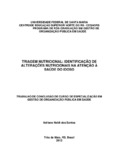| dc.contributor.advisor | Dallepiane, Loiva Beatriz | |
| dc.creator | Santos, Adriane Heldt dos | |
| dc.date.accessioned | 2019-09-25T11:32:08Z | |
| dc.date.available | 2019-09-25T11:32:08Z | |
| dc.date.issued | 2012-12-15 | |
| dc.date.submitted | 2012 | |
| dc.identifier.uri | http://repositorio.ufsm.br/handle/1/18418 | |
| dc.description | Monografia (especialização) - Universidade Federal de Santa Maria, Centro de Educação Superior Norte do Rio Grande do Sul, Curso de Especialização em Gestão de Organização Pública em Saúde, EaD, RS, 2012. | por |
| dc.description.abstract | Purpose: This study aimed at identifying the nutritional conditions of elderly people by using the nutritional screening as a quick procedure in the identification of old people facing nutritional risk as a priority factor in the geriatric health. Method: This research was quantitative, descriptive and transversal and was carried out with elderly people from Palmeira das Missões, RS, Brazil. The variables which were analyzed were: the sociodemographic data, the anthropometric data and the nutritional screening. For the nutritional screening, the instrument called Nutrition Screening Initiative – NSI – was used in order to identify the elderly people who were at nutritional risk. The data were processed with the use of an Excel spread sheet and analyzed with the SPSS statistical software. The methodology for the analysis was the descriptive statistics involving the frequency and the tables, and the association of variables with the Chi—Square test. The research followed the recommendations of the 196/96 Resolution from the National Council of Health (CNS) and was approved by the Ethics Committee for the Research at UFSM – Federal University of Santa Maria. After agreeing with the terms proposed, the subjects of the research signed a Term of Informed Consent. Results: Four hundred and twenty-four (424) elderly people participated in the study, mostly women aging from 60 to 69 years old, married, with about 05 years of formal schooling and monthly income varying from 01 to 02 minimum wages. The nutritional screening identified that 48.9% of them were in good nutritional conditions; however, when we summed the moderate and high risks, they accounted for 51.1%, being superior to the good nutritional status rate. Conclusions: The NSI is an easily applicable instrument, and it can contribute as a strategy in the primary attention moment given to elderly people’s health. | eng |
| dc.language | por | por |
| dc.publisher | Universidade Federal de Santa Maria | por |
| dc.rights | Acesso Aberto | por |
| dc.rights | Attribution-NonCommercial-NoDerivatives 4.0 International | * |
| dc.rights.uri | http://creativecommons.org/licenses/by-nc-nd/4.0/ | * |
| dc.subject | Nutrição | por |
| dc.subject | Envelhecimento | por |
| dc.subject | Desnutrição | por |
| dc.subject | Saúde pública | por |
| dc.subject | Nutrition | eng |
| dc.subject | Aging | eng |
| dc.subject | Malnutrition | eng |
| dc.subject | Public health | eng |
| dc.title | Triagem nutricional: identificação de alterações nutricionais na atenção à saúde do idoso | por |
| dc.type | Trabalho de Conclusão de Curso de Especialização | por |
| dc.degree.local | Polo de Três de Maio, RS, Brasil | por |
| dc.degree.specialization | Gestão de Organização Pública em Saúde, EaD | por |
| dc.description.resumo | Objetivo: identificar a condição nutricional de idosos utilizando a triagem nutricional como um procedimento rápido na detecção de idosos em risco nutricional como prioridade na atenção à saúde geriátrica. Métodos: pesquisa do tipo quantitativa, descritiva e transversal com idosos de Palmeira das Missões, RS. As variáveis analisadas foram:sócio-demográfico, antropométricas e Triagem Nutricional. Para a triagem nutricional foi utilizado o instrumento denominado Nutrition Screening Initiative - NSI (Iniciativa de triagem nutricional) para identificar idosos em risco nutricional. Os dados foram processados em uma planilha do excel e analisados no software estatístico SPSS. A metodologia de análise foi a estatística descritiva envolvendo a frequência e tabelas e associação de variáveis com teste de Qui-Quadrado. A pesquisa seguiu as recomendações da Resolução 196/96 do CNS e foi aprovada pelo Comitê de Ética em Pesquisa da UFSM. Os participantes da pesquisa, após a concordância, assinaram um Termo de consentimento Livre e Esclarecido. Resultados: participaram 424 idosos, sendo a maioria do sexo feminino, predominantemente na faixa de 60 a 69 anos, casados, escolaridade abaixo de 5 anos de estudo e renda de 1 a 2 salários mínimos. A triagem nutricional identificou que 48,9% estão em bom estado nutricional, no entanto quando somado os riscos moderado e alto fica em 51,1% de risco, sendo superior ao bom estado nutricional. Conclusões: O NSI é um instrumento de fácil aplicação, podendo contribuir como estratégia na atenção primária à saúde dos idosos. | por |
| dc.publisher.country | Brasil | por |
| dc.publisher.initials | UFSM | por |
| dc.subject.cnpq | CNPQ::CIENCIAS SOCIAIS APLICADAS::ADMINISTRACAO | por |
| dc.publisher.unidade | Centro de Educação Superior Norte do Rio Grande do Sul | por |



